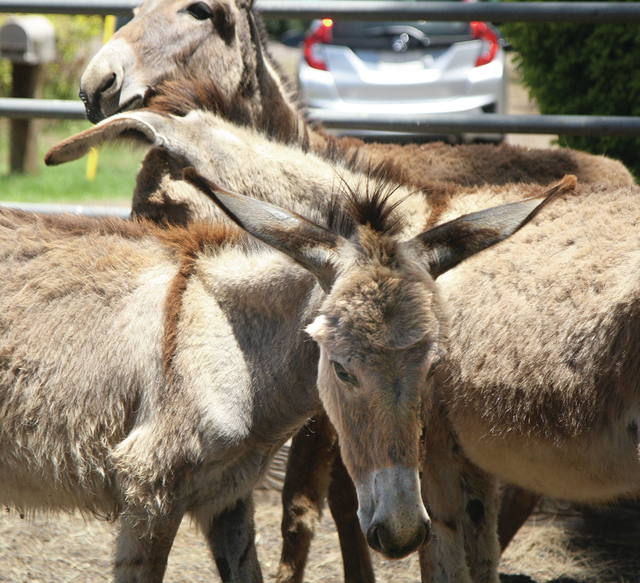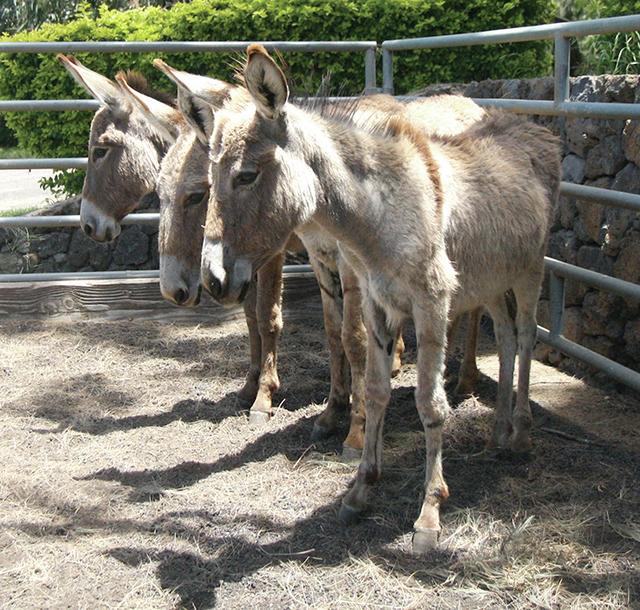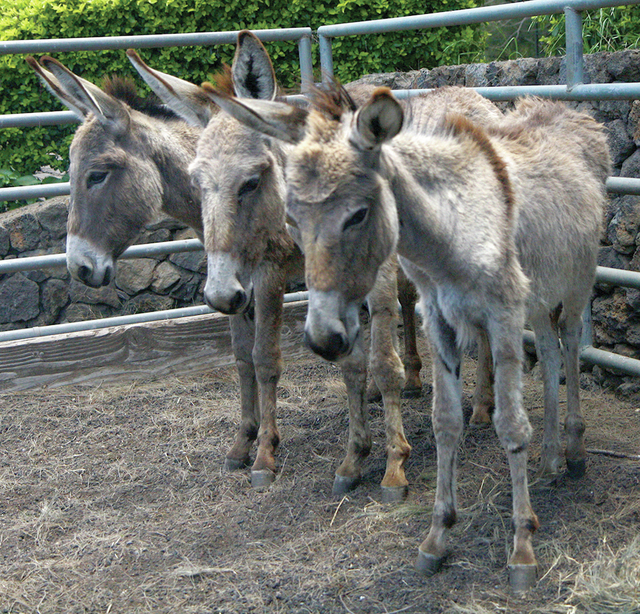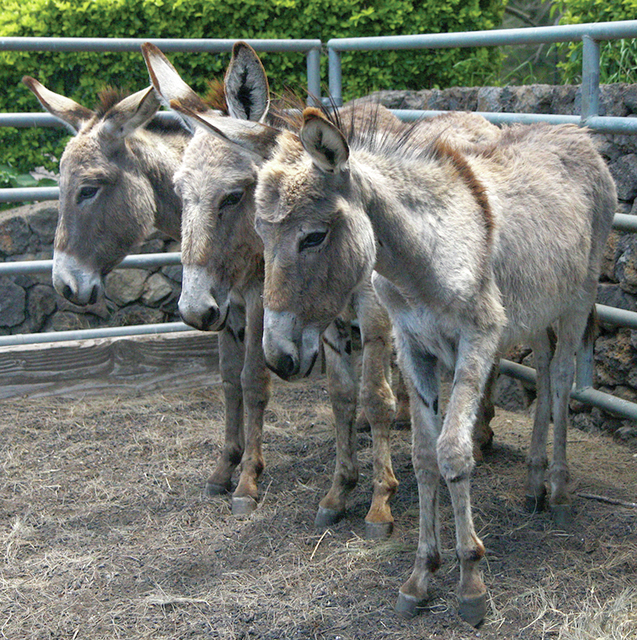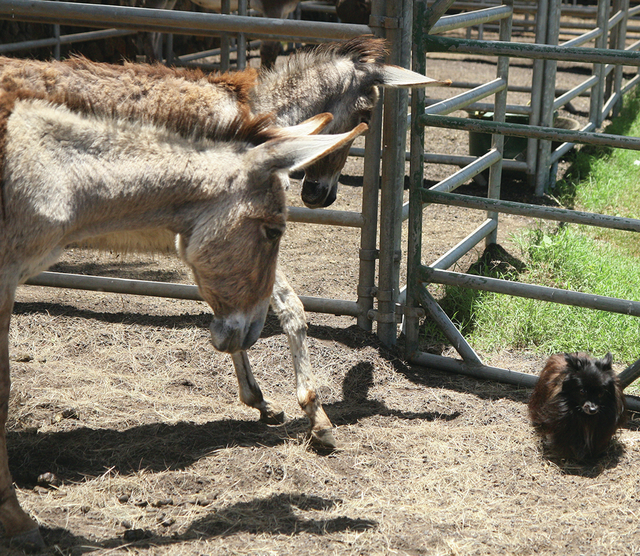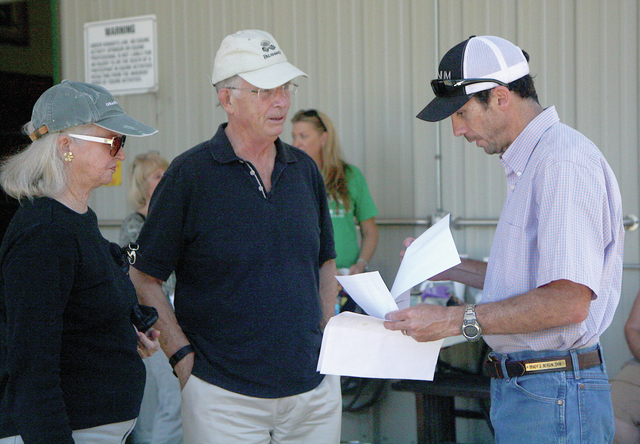KAMUELA— There are no more than 50 feral donkeys left in Waikoloa.
That fact was shared by Inga Gibson of the Humane Society of the United States but after Friday’s adoption, that number trickled even lower.
You read that correctly, a donkey adoption was held. But first, a little back story on how the unique program started.
That 50 figure comes after five years of adoptions from a herd of about 500 animals, a program promoted at the Aina Hou Animal Hospital in Kamuela on Friday.
The program began during the drought of late 2010, when it was so dry and dusty it led the animals to “invade Waikoloa Village,” according to Dr. Brady Bergin.
They were seeking water on golf courses and swimming pools, along with salt in the sand traps, he said.
The conditions were downright terrible.
So rancher Stan Boteilho brought Bergin into the area where the donkeys were. Bergin remembers seeing carcasses, bones and a donkey missing part of its leg.
Bergin is a veterinarian, and he said that working in the field requires a love for animals. He said he couldn’t imagine living with such suffering nearby.
Word spread. Finding the donkeys loving homes — or yards — became a rallying point. Soon, other groups and individuals became involved to support the program.
“Just so many people stepped up,” Bergin said, about what made the wholesale adoption possible.
Donkeys are adapted to the sort of dry, rough terrain in Waikoloa.
“Amazingly a lot of them came off the range quite healthy,” he said.
That all led to the last adoption.
Paul Sennett was there on Friday to adopt another donkey, eyes shining like a child at Christmas. He remembered a stuffed donkey he’d had as a 5 year old, which lead to adopting a living one as an adult.
His donkey, Barney, has been his friend since the donkey was a baby, the child of one of the adopted donkeys from earlier in the program. But Sennett has realized Barney needs a buddy out in the pasture.
That is an important thing for the animal. They are social and need a friend, although it doesn’t have to be another equine. Many donkeys have goats and cows as their comrades.
When Sennett read the West Hawaii Today story on Thursday saying the herd is almost all adopted, he realized he needed to act quickly.
He came up, trying to arrange for a pregnant female to join Barney.
Sennett said they’re like big dogs, but more independent. Unlike a dog that will follow people constantly, hoping for attention or food, the donkeys are more relaxed, he said. He checks up on Barney in the morning and afternoon, feeding him fruit or alfalfa, then his friend heads out to pasture.
Some days he’ll let Barney out of the 2-acre area he normally stays in, allowing the donkey out to a full 30 acres Sennett owns.
Then he’ll mount up on an ATV and go riding, Barney chasing along behind. They’re far more controllable than a horse as well, he said.
At one point Barney was getting a little worked up, so “I put him in a headlock,” Sennett said.
He gestured, smiling, acting as though his right arm was arced over his absent friend.
“And he calmed right down,” he said, his right arm patting an invisible donkey.
For wild animals, they become comfortable around humans rapidly, Bergin said. That’s in part because they are not like horses, who attempt to flee from all danger. Instead, donkeys are willing to test things out.
Within about 48 hours they are noticeably less anxious around people, having realized they are bringing food and water, he said. Within a week most are fully acclimated. One of the amazing adoptions he recalls was a woman who taught the donkey, a wild animal, to give rides.
His commitment to the program comes in part because of what the donkey is.
“Historically they’re one of the most underappreciated animals of all time,” he said.
They’re the true workhorses, he said, and they have carried loads for centuries. That includes a century of service in the Kona coffee industry.
The donkeys of Waikoloa are descended from those animals, abandoned as trucks and other automobiles took over their tasks.
The airlift of 120 donkeys a few years ago to the mainland drew a lot of attention. But Gibson said about 300 of the animals were adopted on the Big Island, most on the west side.
Donkeys can develop foot trouble in wet areas, leading Bergin to prefer adopters on the west side of the island. There are people who have adopted them on the windward side, he said, but the fact they are seen every six month for treatment gives him concerns about their long-term health.
A few donkeys went to Oahu to the Equine 808 rescue on Oahu, and several people on Maui have expressed interest in taking them.
The males are all castrated in the program to prevent another population explosion. The comparable surgery on female equines is more complicated and higher-risk, so the group doesn’t perform it, said Keith Dane, senior adviser on equine protection for the HSUS.
That means they also don’t adopt the females out to people with intact males, either horses or donkeys.
It won’t quite be the end of feral donkeys in Waikoloa.
Boteilho plans to keep a few on the property, Gibson said, but “he doesn’t need 500.”







